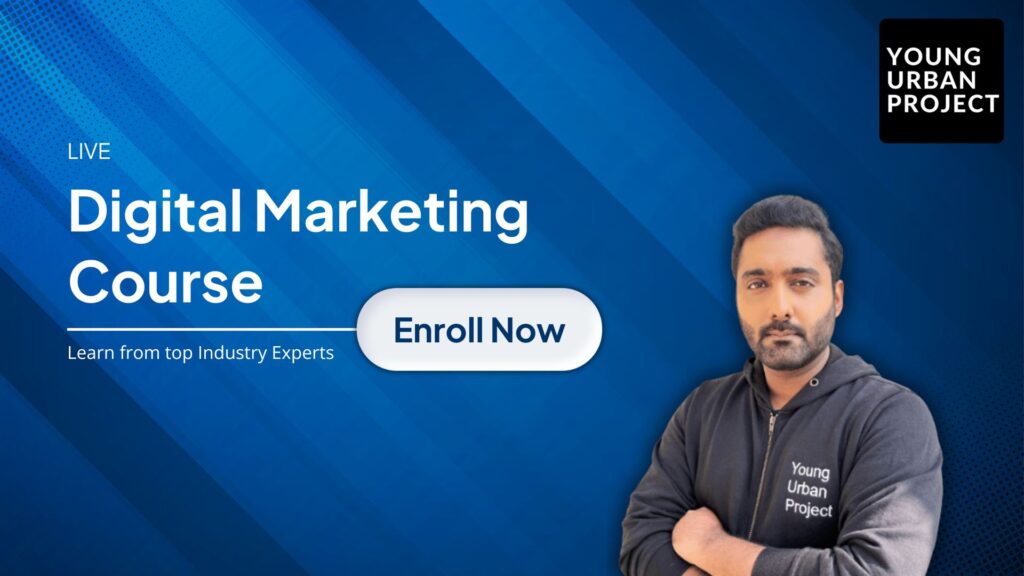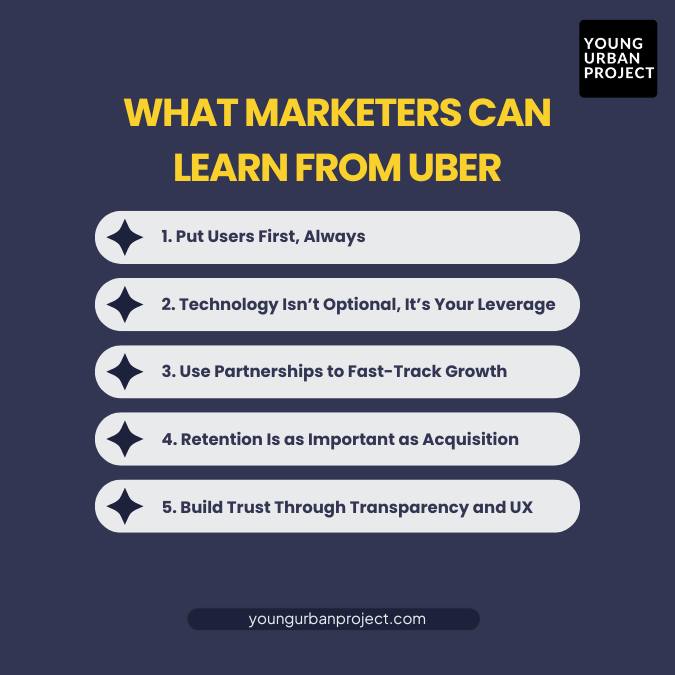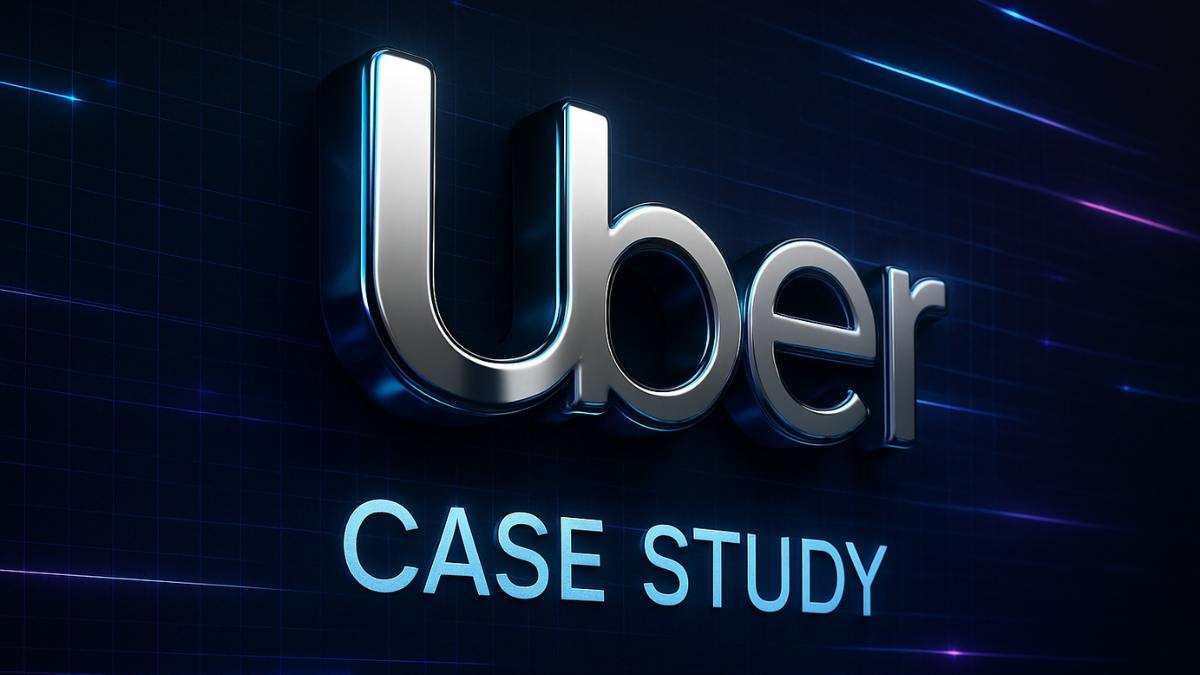When you think of companies that have truly changed the game, Uber has to be on that list. In just over a decade, it’s gone from a scrappy startup in San Francisco to a transportation giant operating in hundreds of cities across the globe. The Uber case study is more than just a story about ride-hailing; it’s a masterclass in tech-driven disruption, growth hacking, and scaling at speed.
And here’s why this is such a goldmine for marketers, startup founders, or anyone trying to build a product that sticks: Uber didn’t invent taxis. It reimagined the experience. From the way it positioned itself to how it leveraged tech and incentives to win both customers and drivers, Uber cracked the code on modern growth.
Let’s break down exactly how.
Table of Contents
About Uber: The Brand in a Nutshell
Uber was founded in 2009 by Travis Kalanick and Garrett Camp, sparked by a simple frustration, not being able to hail a cab on a cold night in Paris. That single moment of inconvenience turned into a world-changing idea.
From there, the company evolved rapidly. Its mission? To ignite opportunity by setting the world in motion. The vision? To make transportation as reliable as running water, everywhere for everyone.
Fast-forward to today, Uber operates in over 70 countries, across 10,000+ cities, offering not just rides, but food delivery, freight logistics, and more. Some major milestones include:
- Launching UberX in 2012 (cheaper rides with everyday cars)
- Expanding into food delivery with Uber Eats (2014)
- IPO in 2019, valued at ~$82 billion (Source)
- Strategic exits from tough markets like China (sold to Didi) and Southeast Asia (merged with Grab)
Also Read: Uniqlo Case Study
Uber’s Unique Selling Proposition (USP)
What really made Uber click with people?
It wasn’t just about getting a ride. It was about convenience and control, knowing who your driver is, tracking the ride in real time, paying through your phone, and rating the experience afterward.
Compared to traditional taxis, Uber was smoother, faster, and felt safer (at least initially). There was pricing transparency, no awkward cash exchanges, and no haggling. Just tap, ride, and go.
That simple, user-first approach, powered by a sleek app, was revolutionary back then. Uber didn’t just offer a service, it redefined commuting.
Also Read: Myntra Case Study
Growth & Market Expansion Strategy
Uber’s growth wasn’t linear. It was more like a blitzkrieg.
- 2009-2011: Started in San Francisco, expanded quickly to New York, LA, and other major U.S. cities.
- 2012-2014: Went international. London, Paris, Sydney, India, and beyond.
- 2015-2017: Entered over 400 cities worldwide, burning serious VC cash to acquire users fast.
Here’s what made their market expansion unique:
- City-by-city strategy: They didn’t do blanket launches. Uber would study a city, understand regulations, onboard drivers, and then go live with localized campaigns.
- Aggressive discounting: Free rides, referral codes, first-time offers, they threw money to acquire both riders and drivers.
- Big funding rounds: Uber raised billions from VCs like Benchmark, SoftBank, and Sequoia. That capital fueled their land-grab strategy.
But they were also pragmatic. In hyper-competitive or regulation-heavy markets like China, Russia, and Southeast Asia, Uber exited via strategic mergers, choosing equity over losses.
Also Read: Advanced Digital Marketing Course in Panchkula
Marketing & Customer Acquisition Strategy
Uber didn’t rely on just one growth lever. It layered multiple tactics smartly.
1. Performance Marketing
From the early days, Uber spent big on Google Ads, Facebook, and App Store optimization. They had hyper-local campaigns targeted by city, time, even traffic patterns.
2. Influencer & Social Campaigns
In cities with tight communities (like college towns), they used local influencers and college reps to spark buzz.
3. Rider vs. Driver Messaging
They smartly split campaigns for two very different audiences. Riders saw ease, savings, and safety. Drivers saw flexibility, income potential, and control.
4. Promo-Driven Growth
Uber’s early growth was fueled by discounting, free first rides, referral bonuses (give ₹100, get ₹100), and seasonal promos.
It was classic CAC vs. LTV balancing, spend more upfront to own the market.

Enroll Now: Advanced Digital Marketing Course
CRM & Retention Tactics That Drove Loyalty
Once Uber got users in, they focused on keeping them.
1. Strategic Partnerships
- Spotify Integration: Riders could control music during their trip.
- Payment App Tie-Ups: Integration with wallets like Paytm in India.
- Airline & Hotel Collaborations: Earn miles or discounts with Uber rides.
2. Loyalty Programs
- Uber Rewards and now Uber One offer perks like priority support, price locks, and discounts, building stickiness.
3. Referral Engine
Uber’s viral loop was genius. Invite friends, get free rides. This wasn’t just marketing, it was product-led growth.
4. Uber Eats Ecosystem
Cross-promoting rides and food delivery added another layer to user retention. One app, multiple services = increased daily active use.
Also Read: Netflix Case Study
Tech & UX: Powering the Uber Experience
Uber isn’t just a transport company. It’s a tech company at heart.
- Real-Time GPS Tracking: See your driver approach, live.
- Dynamic Pricing (Surge): Adjusting fares based on demand.
- ETA Calculations: Based on real-time traffic and location data.
- Driver-Rider Rating System: Mutual accountability and quality control.
- Scalable Cloud Infrastructure: Handles millions of simultaneous users.
They also use machine learning to:
- Predict demand
- Optimize routes
- Match riders to nearby drivers more efficiently
All of this made the app experience feel magical, especially in the early days.
Also Read: Starbucks Case Study
Competitive Analysis: How Uber Stacks Up
Uber has faced stiff competition globally.
- Lyft (U.S.): Focused on driver satisfaction, customer service
- Ola (India): Deep localization, cash payments
- Bolt & Yandex (Europe/Russia): Lower fees, alternative models
Uber’s response?
- Innovation: Uber Pool, Uber Moto, Uber Auto, Uber Freight
- Adaptability: Letting drivers use cash in cash-heavy countries
- Diversification: Moving into logistics, delivery, and even self-driving R&D
What Makes Uber a Global Success Story?
It boils down to a few key things:
- Network Effect: More riders attract more drivers, and vice versa.
- Brand Trust: Despite hiccups, users still open the Uber app when they need a ride.
- Adaptability: Willingness to localize or pivot when needed.
- Leadership: From Kalanick’s bold aggression to Dara’s strategic stability, Uber evolved.
Also Read: Coca-Cola Case Study
What Marketers Can Learn From Uber

1. Put Users First, Always
Uber didn’t just create a product, it solved a real problem. The obsession with user experience showed in every interaction, from the app design to the service flow. For marketers and product builders, it’s a reminder that real growth starts when you make life easier for your user, not just when you advertise better.
2. Technology Isn’t Optional, It’s Your Leverage
Uber’s growth wasn’t just because of flashy ads. It was the behind-the-scenes tech, GPS tracking, real-time ETAs, smart routing, that made it frictionless. For startups, integrating tech meaningfully into your offering can multiply your reach, improve efficiency, and create experiences that keep people coming back without constant re-marketing.
3. Use Partnerships to Fast-Track Growth
Uber didn’t grow alone. They collaborated with brands like Spotify, credit card companies, airlines, and food delivery services to create value across multiple touchpoints. Strategic partnerships can open doors you can’t afford to open yourself, especially when you’re trying to scale fast with limited resources.
4. Retention is as Important as Acquisition
It’s easy to throw money at ads and get downloads or sign-ups. But Uber invested in rewards, referrals, and an ecosystem that encouraged repeat usage. The real win comes when your users stick around. CRM, loyalty programs, and consistently good experiences are what help you grow sustainably over time.
5. Build Trust Through Transparency and UX
People don’t just want convenience, they want to feel in control. Uber gained early trust by showing who the driver is, when they’ll arrive, what the ride will cost, and letting users rate every trip. Clear communication and honest UX design can do more for your brand than a million-dollar campaign.
Also Read: McDonald’s Case Study
Conclusion
Uber didn’t just build an app, it built a movement. It transformed how we think about transport, logistics, and platform-based marketplaces.
As marketers and founders, we don’t have to copy Uber, but we can learn from how they scaled, adapted, and innovated.
So, whether you’re working on a product, scaling an agency, or growing a startup, the Uber case study is worth bookmarking. It’s proof that with the right mix of tech, user obsession, and guts, even the most traditional industries can be flipped upside down.
Also Read: Amazon Case Study
FAQs – Uber Case Study
Q1. What is Uber’s main business model?
Uber runs on a two-sided marketplace model. It connects riders and drivers using a mobile app, taking a percentage from each ride while managing payments, logistics, and customer experience.
Q2. How did Uber grow so fast?
A mix of aggressive marketing, smart referrals, massive VC funding, and a tech-first product helped Uber expand quickly. They scaled city-by-city, offering promotions and building local operations fast.
Q3. What makes Uber’s app so user-friendly?
The app is clean, fast, and removes friction. Real-time location tracking, cashless payments, upfront pricing, and a simple interface all make it easy for anyone to use without confusion.
Q4. How does Uber retain customers long-term?
They combine loyalty rewards, constant app upgrades, cross-platform services like Uber Eats, and personalized promos to keep users coming back. Plus, their referral engine creates a natural loop for retention.
Q5. What challenges has Uber faced globally?
Uber’s biggest hurdles have been regulatory issues, driver protests, pricing complaints, and losses in certain countries. Each region brought new legal and competitive challenges that forced adaptation or exits.
Q6. What can startups learn from Uber’s growth strategy?
Solve something real, obsess over product experience, and scale with smart partnerships. Growth isn’t about burning money, it’s about creating value users feel instantly and repeatedly.

